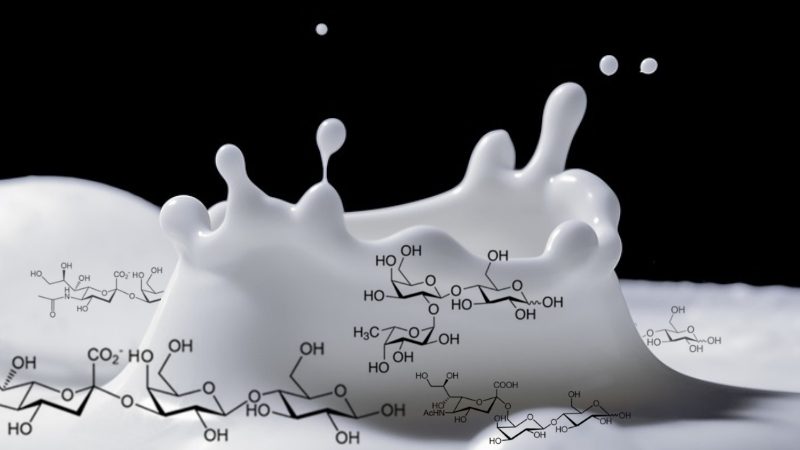Human Milk Oligosaccharides (HMOs) are powerful bioactive molecules that play a critical role in infant health, from gut microbiota development to immune protection.
As the fourth most abundant component in human milk, after lactose, lipids, and proteins, HMOs provide essential benefits that cannot be replicated by standard infant formula (Bode, 2012).
HMOs are not static; their composition and concentration change throughout lactation. Colostrum (first milk after birth) contains the highest concentration of HMOs (about 17.7 g/L). As lactation progresses, total HMO levels decline, with mature milk containing approximately 11.3 g/L (Soyyılmaz et al., 2021).
Some HMOs, such as 2′-Fucosyllactose (2′-FL), decrease over time, while others, like 3-Fucosyllactose (3-FL), increase in concentration (Soyyılmaz et al., 2021).
This natural evolution of HMO composition suggests that different HMOs serve different functions at different stages of an infant’s development, optimizing their gut health and immune protection.
One of the most well-documented roles of HMOs is their prebiotic effect – they serve as food for beneficial gut bacteria, particularly Bifidobacterium species, which are key players in a healthy gut microbiome (Walsh et al., 2020).
Bifidobacteria ferment HMOs into short-chain fatty acids (SCFAs), which contribute to gut maturation and immune regulation (Akkerman et al., 2019).
HMOs help establish a beneficial microbiota that outcompetes harmful bacteria and prevents gut dysbiosis, a condition linked to diseases like colic, allergies, and even obesity later in life (Walsh et al., 2020).
Beyond their role as prebiotics, HMOs directly protect infants from infections by acting as antiadhesive antimicrobials – they mimic cell surface receptors that pathogens typically bind to, preventing harmful bacteria and viruses from attaching to the gut lining (Bode, 2012).
HMOs have been shown to reduce the risk of diarrhea-causing pathogens, including Escherichia coli and Campylobacter jejuni (Walsh et al., 2020).
They also help protect against necrotizing enterocolitis (NEC), a life-threatening gut disease in preterm infants. Research indicates that certain HMOs, like Disialyllacto-N-tetraose (DSLNT), significantly lower the risk of NEC (Bode, 2012).
By acting as natural decoys, HMOs help infants fight infections without the need for antibiotics, reducing the likelihood of antibiotic resistance and long-term gut imbalances.
HMOs play an essential role in shaping the infant immune system, reducing inflammation and promoting immune tolerance.
They modulate immune cell activity, promoting the development of regulatory T cells (Tregs) that help prevent autoimmune diseases (Akkerman et al., 2019).
Research suggests that infants consuming HMO-enriched formulas show lower levels of inflammatory markers, indicating that HMOs help balance immune responses (Vandenplas et al., 2018).
HMOs may also be linked to lower risks of allergic diseases, such as eczema and asthma, by supporting a healthy gut barrier and immune regulation (Walsh et al., 2020).
With the increasing understanding of HMOs’ importance, researchers have developed synthetic HMOs through biotechnological methods. These bioengineered HMOs, such as 2′-FL and Lacto-N-neotetraose (LNnT), have been added to some infant formulas to mimic the benefits of breast milk (Bych et al., 2019).
However, challenges remain.
Synthetic HMOs are expensive to produce, making them less widely available in all formulas (Bych et al., 2019).
Most formulas still lack the full range of diverse HMOs found in human milk, which means their benefits may be incomplete compared to breastfeeding (Akkerman et al., 2019).
To compensate, some formulas use non-digestible carbohydrates (NDCs) as HMO substitutes. However, while these ingredients can support gut health, they do not fully replicate all HMO functions, particularly in immune modulation and pathogen defense (Akkerman et al., 2019).
The benefits of HMOs are not limited to infants.
Research suggests potential applications in adult health, particularly in treating gut disorders, metabolic diseases, and immune-related conditions (Bych et al., 2019). Scientists are exploring HMOs as:
Prebiotics for adults, especially for people with irritable bowel syndrome (IBS) and inflammatory bowel disease (IBD).
Immune-boosting agents for people prone to infections or autoimmune diseases.
Gut microbiota modulators to support overall health and longevity.
As the science behind HMOs advances, their potential therapeutic applications beyond infancy could lead to new medical and nutritional breakthroughs.
While biotechnology has made it possible to add some HMOs to infant formula, breastfeeding remains the gold standard for providing infants with the full spectrum of HMOs and their health benefits.
As research progresses, HMOs may become key ingredients in future medical and nutritional innovations, benefiting people of all ages.
References:
Akkerman, R., Faas, M., & De Vos, P. (2019). Non-digestible carbohydrates in infant formula as substitution for human milk oligosaccharide functions: Effects on microbiota and gut maturation. Critical Reviews in Food Science and Nutrition, 59, 1486-1497. https://doi.org/10.1080/10408398.2017.1414030
Bode, L. (2012). Human milk oligosaccharides: Every baby needs a sugar mama. Glycobiology, 22(9), 1147-1162. https://doi.org/10.1093/glycob/cws074
Bych, K., Mikš, M., Johanson, T., Hederos, M., Vigsnæs, L., & Becker, P. (2019). Production of HMOs using microbial hosts – From cell engineering to large-scale production. Current Opinion in Biotechnology, 56, 130-137. https://doi.org/10.1016/j.copbio.2018.11.003
Soyyılmaz, B., Mikš, M., Röhrig, C., Matwiejuk, M., Meszaros-Matwiejuk, A., & Vigsnæs, L. (2021). The Mean of Milk: A Review of Human Milk Oligosaccharide Concentrations Throughout Lactation. Nutrients, 13. https://doi.org/10.3390/nu13082737
Vandenplas, Y., Berger, B., Carnielli, V. P., Ksiazyk, J., Lagström, H., Sanchez Luna, M., Migacheva, N., Mosselmans, J. M., Picaud, J. C., Possner, M., Singhal, A., & Wabitsch, M. (2018). Human Milk Oligosaccharides: 2′-Fucosyllactose (2′-FL) and Lacto-N-Neotetraose (LNnT) in Infant Formula. Nutrients, 10(9), 1161. https://doi.org/10.3390/nu10091161
Walsh, C., Lane, J., Van Sinderen, D., & Hickey, R. (2020). Human milk oligosaccharides: Shaping the infant gut microbiota and supporting health. Journal of Functional Foods, 72, 104074. https://doi.org/10.1016/j.jff.2020.104074

